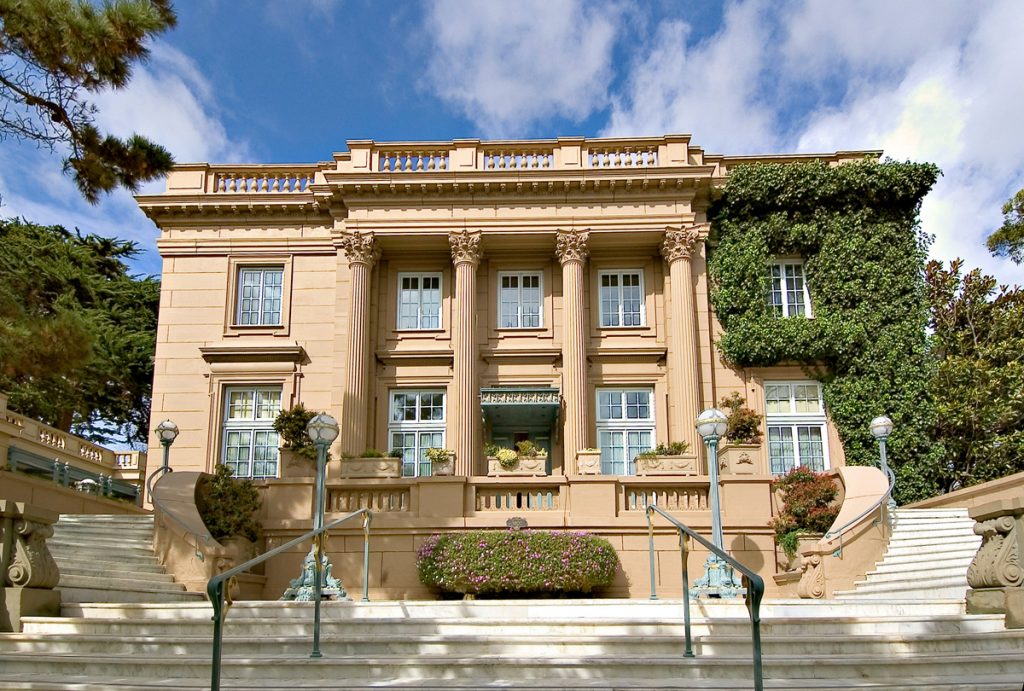By BRIDGET MALEY
with KAMALA MOSTERT
Having recently visited Versailles, it is easy to see how Corrine Koshland became so enamored with the estate’s Le Petit Trianon that she commissioned a copy as her family home in San Francisco.
In September 1900, Corinne and Marcus Koshland, their three young children, Daniel, Robert and Margaret, along with a nursemaid, embarked on an arduous journey via rail and sea to Europe. In France, Corinne fell in love with the Palace of Versailles, the royal residence of France beginning in 1682 under Louis XIV, until the start of the French Revolution in 1789.
Specifically, it was the Petit Trianon that caught Corinne’s attention. Completed in 1768, the garden pavilion situated within the larger Versailles gardens was designed by Ange Jacques Gabriel. Originally conceived for Madame de Pompadour, Louis XV’s mistress, Louis XVI later presented the garden pavilion to his young bride, Marie Antoinette, who immediately began an elaborate reworking of the interiors and gardens. The Petit Trianon, from its inception, had a strong female presence. This too, likely inspired Corinne Koshland, who later became a grande dame of San Francisco, entertaining extensively in her home.
Corinne Koshland’s husband, Marcus Simon Koshland, was a prominent San Francisco wool merchant with a sizable fortune. His father, Simon Koshland, had arrived from Europe in 1850, settling first in Sacramento and then moving to San Francisco in 1862, establishing S. Koshland & Co. Corinne Schweitzer, the daughter of Bernard and Rebecca Schweitzer, was an heir to a million dollar estate. Her father arrived in California in 1852 from Europe and was a founding partner of one of San Francisco’s larger wholesale firms, Schweitzer, Sachs & Co., a purveyor of fancy goods and furnishings. The marriage of these two prominent Jewish families on October 7, 1890, was a mingling of two pioneering, Gold Rush era, merchant class families.
Channeling her inner Marie Antoinette, Corinne hired architect Frank S. Van Trees to bring the elegance and opulence of France to the sand dunes of San Francisco. With her father’s gift of a corner lot at Washington and Maple Streets in Presidio Heights, Corinne set out with Van Trees to replicate the Petit Trianon. The Washington Street facade faithfully replicates the west garden facade of the French original, with its elegant front entry and four majestic Corinthian columns.
Completed in 1904, the Koshland house at 3800 Washington Street comprised nearly 18,000 square feet, with eight fireplaces and more than 20 rooms, plus a three-story atrium rising in the center supported by marble columns. The first floor featured conservatories on either side of the marble rotunda. The three monumental Art Nouveau stained glass windows on the Maple Street facade are the work of Bruce Porter, a native San Franciscan polymath who was a proponent of the Arts & Crafts movement, a working artist, writer and landscape designer. Porter created the gardens at Filoli, the Bourn estate in Woodside. He also painted the murals at Nob Hill’s Pacific Union Club and designed the stained glass windows for the neighorbood’s Swedenborgian Church.
After the home suffered extensive damage from the 1906 earthquake, Marcus Koshland was quoted on the front page of the San Francisco Call optimistically debunking the myth that small homes would be built as replacements. “I will replace everything just as it was,” he said. “We are to have in San Francisco more magnificent homes than ever before! I know of several property owners who intend to build beautiful residences on the heights. The city will recover from this shock in surprisingly quick time. I have unbounded faith in it and so have all the businessmen with whom I have spoken.”
Ever the socialite and philanthropist, Corinne Koshland, eager to share her passion for music, hosted many concerts and social events in the home. With the completion of a 1912 renovation that added an elaborate basement level ballroom, the Koshlands hosted an 18th century themed soiree, greeting their guests dressed in elaborate Louis XVI and Marie Antoinette costumes, with Marcus adorned in royal purple and Corinne draped in white brocade with a cloak and train of “Marie Antoinette blue.”
As founder of the San Francisco Symphony Association and one of the first directors of the San Francisco Opera, Corinne Koshland shared the home as a stage for many prominent musicians, including Yehudi Menuhin and Isaac Stern, both of whom had their childhood musical debuts at the Koshland house. Corrine was one of several sponsors of Stern’s musical education. Stern would later become a world renowned violinist and arts activist, saving Carnegie Hall from demolition in the 1960s and helping establish the National Endowment for the Arts in 1964. Igor Stravinsky, Jascha Heifetz and Leonard Bernstein all played within the marble atrium of the local Petit Trianon, where more than 100 guests could sit comfortably.
Corinne Koshland died on October 14, 1953, having outlived her husband by 28 years. In March 1955, Walter E. Buck purchased the home for $100,000, and lived there until 1977, when the house was purchased by attorney Paul Renne for $525,000. It changed hands again before being owned by Joe and Heide Betz and, later, internet pioneer Halsey Minor, who lost it in a bankruptcy sale. It recently sold again after a long vacancy for a reported $15.75 million.
From April 27 to May 27, 2019, the home will be open to the public, housing the annual University High School Decorator Showcase. This will be the second time the home has hosted the showcase, having previously been lavishly decorated in 1982.
Filed under: Bridget Maley, Landmarks






